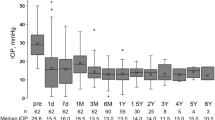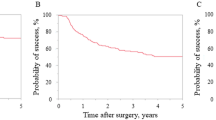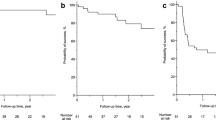Abstract
Background
Childhood glaucoma is a rare condition that presents a significant management challenge often requiring surgical intervention. This study evaluates the epidemiology, efficacy and safety profile of Baerveldt glaucoma drainage devices (GDDs) in an Australian paediatric population over ten years.
Methods
A retrospective review of all patients under 18 years who underwent anterior chamber Baerveldt 101–350 implantation between January 2014 and January 2024 in an Australian tertiary referral centre was conducted. Patient characteristics, ocular examination and surgical details were collected. Survival rates were estimated using Kaplan-Meier analysis.
Results
Eighty-one Baerveldt GDDs were inserted in 80 eyes of 63 children at median 4.0 years. Prior glaucoma surgery was documented in 48.1% of cases. The most common indication was refractory glaucoma following cataract surgery (38.8%). A significant reduction in intraocular pressure (IOP) and medication requirement was observed at final follow-up (p < 0.001), with 36.3% of eyes requiring no glaucoma medications. The one-, five- and ten-year survival rates were 90.1%, 71.1% and 62.9% respectively. Twenty GDDs failed, predominantly due to elevated IOP. Complications occurred in 12.3% of cases with the most common being hypotony (4.9%) followed by tube retraction (3.7%).
Conclusion
Baerveldt 101–350 GDDs can provide effective long-term IOP control with a favourable safety profile. We noted a higher proportion of patients with glaucoma following cataract surgery in comparison to previous studies. Outcomes of this large single surgeon series compare favourably with existing literature and support the use of Baerveldt GDDs as a reliable option in childhood glaucoma refractory to other approaches.
This is a preview of subscription content, access via your institution
Access options
Subscribe to this journal
Receive 18 print issues and online access
$259.00 per year
only $14.39 per issue
Buy this article
- Purchase on SpringerLink
- Instant access to full article PDF
Prices may be subject to local taxes which are calculated during checkout

Similar content being viewed by others
Data availability
The datasets generated during and/or analysed during the current study are available from the corresponding author on reasonable request.
References
Weinreb RN, Grajewski AL, Papadopoulos M, Grigg J, Freedman S, editors. Childhood glaucoma. Amsterdam: Kugler Publications; 2013.
Jacobson A, Besirli CG, Bohnsack BL. Outcomes of Baerveldt glaucoma drainage devices in pediatric eyes. J Glaucoma. 2022;31:468–77.
Stallworth JY, O’Brien KS, Han Y, Oatts JT. Efficacy of Ahmed and Baerveldt glaucoma drainage device implantation in the pediatric population: a systematic review and meta-analysis. Surv Ophthalmol. 2023;68:578–90.
Elhusseiny AM, Hassan AK, Azhari JO, Elkheniny FD, Chauhan MZ, Chang TC, et al. Ahmed and Baerveldt glaucoma drainage devices in childhood glaucoma: a meta-analysis. J Glaucoma. 2023;32:686–94.
Christakis PG, Kalenak JW, Tsai JC, Zurakowski D, Kammer JA, Harasymowycz PJ, et al. The Ahmed versus Baerveldt study: five-year treatment outcomes. Ophthalmology. 2016;123:2093–102.
Aponte EP, Diehl N, Mohney BG. Incidence and clinical characteristics of childhood glaucoma: a population-based study. Arch Ophthalmol. 2010;128(Apr):478–82.
Thau A, Lloyd M, Freedman S, Beck A, Grajewski A, Levin AV. New classification system for pediatric glaucoma: implications for clinical care and a research registry. Curr Opin Ophthalmol. 2018;29:385–94.
Shaarawy T, Grehn F. Guidelines on design and reporting of glaucoma surgical trials. Amsterdam: Kugler Publications; 2009.
Chiang MY, Camuglia JE, Khaw PT. A novel method of extending glaucoma drainage tube: “tube-in-tube” technique. J Glaucoma. 2017;26:93–5.
Britt MT, LaBree LD, Lloyd MA, Minckler DS, Heuer DK, Baerveldt G, et al. Randomized clinical trial of the 350-mm2 versus the 500-mm2 Baerveldt implant: Longer term results: is bigger better?. Ophthalmology. 1999;106:2312–8.
van Overdam KA, de Faber JT, Lemij HG, de Waard PW. Baerveldt glaucoma implant in paediatric patients. Br J Ophthalmol. 2006;90:328–32.
Author information
Authors and Affiliations
Contributions
CYL was responsible for designing the study protocol, collecting data and writing the report. ASL and MC supervised the protocol design and provided feedback on the report.
Corresponding author
Ethics declarations
Competing interests
The authors declare no competing interests.
Additional information
Publisher’s note Springer Nature remains neutral with regard to jurisdictional claims in published maps and institutional affiliations.
Supplementary information
Rights and permissions
Springer Nature or its licensor (e.g. a society or other partner) holds exclusive rights to this article under a publishing agreement with the author(s) or other rightsholder(s); author self-archiving of the accepted manuscript version of this article is solely governed by the terms of such publishing agreement and applicable law.
About this article
Cite this article
Liu, C.YY., Lee, A.S. & Chiang, M.YM. A ten-year study of Baerveldt glaucoma drainage device in an Australian paediatric population. Eye (2025). https://doi.org/10.1038/s41433-025-04060-1
Received:
Revised:
Accepted:
Published:
DOI: https://doi.org/10.1038/s41433-025-04060-1



